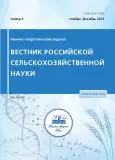The effectiveness of improving plant selection in obtaining potato minitubers
- Authors: Evstratova L.P1, Kuznetsova L.A1, Nikolaeva E.V1
-
Affiliations:
- Karelian Scientific Center of the Russian Academy of Sciences
- Issue: No 6 (2023)
- Pages: 61-64
- Section: Articles
- URL: https://journals.rcsi.science/2500-2082/article/view/233577
- DOI: https://doi.org/10.31857/2500-2082/2023/6/61-64
- EDN: https://elibrary.ru/WQAXHS
- ID: 233577
Cite item
Full Text
Abstract
About the authors
L. P Evstratova
Karelian Scientific Center of the Russian Academy of Sciences
Email: levstratova@yandex.ru
L. A Kuznetsova
Karelian Scientific Center of the Russian Academy of Sciences
E. V Nikolaeva
Karelian Scientific Center of the Russian Academy of Sciences
References
- Биотехнологические методы получения и оценки оздоровленного картофеля. М.: Агропромиздат, 1988. 34 с.
- ГОСТ 33996-2016 «Картофель семенной. Технические условия и методы определения качества». М.: Стандартинформ, 2020. 45 с.
- Доспехов Б.А. Методика полевого опыта. М.: Колос, 1979. 416 с.
- Евстратова Л.П., Кузнецова Л.А., Николаева Е.В. и др. Сочетание методов апикальной меристемы и клонового отбора в оригинальном семеноводстве Solanum tuberosum L. // Ученые записки Петрозаводского государственного университета . 2018. № 8 (177). С. 23-26.
- Ким Дж.-О., Мьюллер П.У., Клекка У.Р. и др. Факторный, дискриминантный и кластерный анализ. М.: Финансовая статистика, 1989. 215 с.
- Князева Т.В. Регуляторы роста растений в Краснодарском крае: монография. Краснодар: ЭДВИ, 2013. 128 с.
- Лебедев В.Г., Азарова А.Б. Шестибратов К.А. и др. Проявление сомаклональной изменчивости у микроразмноженных и трансгенных растений // Известия ТСХА. Вып. 1. 2012. С. 153-163.
- Полухин Н.И., Мызгина Г.Х. Преимущества использования улучшающего отбора при производстве оригинальных семян картофеля // Сибирский вестник сельскохозяйственной науки. 2015. № 1. С. 25-31.
- Сельскохозяйственная биотехнология: Учебник / В.С. Шевелуха, Калашникова, Е.З. Кочиева и др.; Под ред. B.C. Шевелухи. 3-е изд., перераб. и доп. М.: Высш. шк., 2008. 710 с.
- Факторный анализ (подход с использованием ЭВМ): Методическое пособие. Сост. В. Н. Харин. Петрозаводск: КарНЦ РАН, 1992. 190 с.
- Ehsanpour A.A., Madani S., Hoseini M.В. Detection of somaclonal variation in potato callus induced by UV-C radiation using RAPD-PCR // Gen. Appl. Plant Physiol. 2007. Vol. 33. P. 3-11.
Supplementary files










